Anyone who has seen the movie, Ratatouille, knows the famous scene where the dish of ratatouille transports for restaurant critic back to his childhood.
Tex-Mex can have the same effect on me. Truthfully, there are a lot of things to not like about the mess that we call the combination dinner. Too much salt. Too much grease. No vegetables to speak of. Artery clogging cheese and meat. And I have joked that if an alien was dropped into Texas and served up a big old mess of Tex-Mex, he might remark, "What the heck is this on my plate?"
But for those of us who grew up here, Tex-Mex seems very right and we love it. As a kid, my family ate at an El Patio on Telephone at Park Place at least twice a week.
In the eighties, new menu items started appearing and certainly there are now many restaurants that offer fare more typical of the food of northern Mexico and other regions. For example, the menu at the charming Morales on 76th Street could as easily be the menu of a small comedor (eatery) in Monterrey, Mexico.
With my recent very positive experience with what I fondly call Retro Tex-Mex at Spanish Village on Almeda (established 1953), I thought that I would put together a list of favorite places that, if one could time travel back to 1960's Houston, these would be the combination plates that one might be served.
Now, I know that my suggestions are going to generate a lot of "why did you choose that place and not this place" comments in the comments section. Well, this is not an exclusive list. It's a starting point for your explorations around town. Some you will probably recognize. Others may be off your radar and new to you. Feel free to add your own suggestions in the comments section.
And so, here begins my list, a list of restaurants where that combo plate will have frijoles refritos, arroz a la Mexican, a flour/oil/chili powder "chili" gravy to cover the enchiladas and tamales. The tortillas for the enchiladas will have been dipped in hot out to soften and then stacked until ready to use. The rice will be slightly red from tomatoes, seasoned with cumin and hopefully, light and fluffy. The beans may be watery or slightly thick and probably made with pinto beans. If you are lucky, the crispy taco shell will be puffy and inflated like a balloon (Los Tios is the only place that I know of that still do these...but, I am talking with Spanish Village to see if they might be interested in figuring out the recipe with me; I'm pretty sure that it is critical to use yellow corn nixtamal as, when I tried to make them with white corn nixtamal, they absorbed too much oil and got soft after a few minutes).
Here is a link to this article, as originally written for and published in Phaedra Cook's Houston Food Finders:
Houston Food Finder - Houston Retro Tex-Mex Link
416 76th Street
www.doncarlosrestaurants.com
On the east side of town, what is becoming known as Eado, though, we prefer the name
304 Holland Avenue, Galena Park
2601 Navigation Boulevard
Damn, that puffy taco plate was good. The rice and beans that accompanied it were great. As were the tacos. Crunchy. Not those softer, chewier, thick masa ones that SA is known for. A tad thicker than the ones at the (now closed) beloved Fiesta Loma Linda.
And, I saw that caldo de menudo is a daily feature. Not just on weekends.
This is a breakfast and lunch place. It closes at 2:00 pm.
El Toro Mexican Restaurants
Baytown (3 locations) and Various Locations in La Porte, Lake Jackson and other cities
La Plaza
1803 Bingle Road
Established in 1964 and serving classic Tex-Mex. A bowl of chile con queso arrives at your table with the menu. Go for the combination plate #1.
El Penjamo
6110 Lyons Avenue
My father's first store, a little 5 & 10 Variety Store, was on Lyons Avenue and my earliest memories are of this area in the 50's. On a recent visit, I discovered three Mexican restaurants along the street. El Penjamo has a menu featuring the dishes from Northern Mexico and the carne guisada plate looked really good. However, I was here for the Tex-Mex offering and ordered the #1 which was pretty amazing. Check out the color of the cheeses. Looks like they used one of those nacho cheeses for the queso and standard cheddar for the enchiladas. The meal begins with a small bean and fideo soup.
El Potosino
Galena Park, Texas) on Clinton Drive
The restaurant was established in 1970 and the recipes are the same as then so we are talking about a time machine, time warp of about 50 years. Classic old school Tex-Mex.
Don Key Mexican Restaurant
5010 Spencer Highway, Pasadena
Established in 1984. I came across this time warp treasure via their billboard on Old Galveston Road that I noticed one day when driving back into Houston.
Los Tios (Beechnut)
4840 Beechnut Street
www.lostiosrestaurant.com
Los Tios is a Houston institution and currently the only place that still make the puffy and crispy taco that was once very typical of Houston Tex-Mex. This location on Beechnut is a favorite.
3401 N. Shepherd at 34th Street
www.misombrero.com
Mi Sombrero offers classic Tex-Mex dishes and like Don Teo, serves the Garden Oaks and Shepherd/Ella area of Houston. For my taste, a little on the salty side. But hey, it's Tex-Mex.
Lopez Mexican Restaurant
11606 Wilcrest Drive
www.vivalopez.com
Another historically significant, classic Tex-Mex institution. This one serves the Stafford, Hwy 59 at Wilcrest Houston area.
Monterey House (Beaumont, Texas)
1109 S 11th Street, Beaumont, Texas
www.monteryhousebmt.com
OMG. The holy grail. The mecca for lovers of classic, retro Tex-Mex. The franchisee bought the rights to the recipes of the original Monterey House chain in the 60's and continues to duplicate the original recipes. A must stop for anyone travelling east on Highway 10 through Beaumont. For more details, please see this link:
Monterey House - Beaumont
Larry's (Richmond, Texas)
116 E Highway 90A, Richmond
Larry Guerrero worked for Felix Tijerina back in the day, and, when he expressed interest in creating his own Mexican restaurant, Mr. Tijerina provided assistance. Ninfa Laurenzo also offered help in exchange for his buying his masa products from their family tortilleria off of Navigation.
Be sure to pick up a Larry's t-shirt when you visit. It is one of the coolest looking t-shirts in Texas.
La Hacienda (Memorial) (And also in the Greater Heights)
14759 Memorial Drive
If you grew up in the Memorial area, your family probably went to "La-Ha" at least once a week. It is a Tex-Mex institution for Memorialites.
Old Mexico (Northside)
3306 Hopper Road
This is about as old school as you can get. Red tortillas for the enchiladas, salsa and queso served with chips, classic rice and beans. Yep. You will want to get the enchilada plate here. Note: there isn't a sign outside so you may actually pass by Old Mexico the first time that you try to find it.
Las Hadas (Permanently Closed)
2428 Center Street, Deer Park, Texas
I really liked, and recommend you order the biggest combination plate on the menu in order to sample a little bit of everything. Although the rice wasn't as light and fluffy as I would like it to be, I thought the frijoles refritos were really good. The beef (picadillo) in the taco tasted cleaner and less greasy than in a lot of places. And the combo plate has real chile con carne gravy instead of the typical chili gravy.
Fiesta Loma Linda - (Permanently Closed)
2111 Telephone Road
http://www.fiestalomalinda.com
(We are sad to advise that, after 62 years, Fiesta Loma Linda closed in May of 2018):
Our favorite because of the classic, Houston style puffy tacos that they continue to make and make well. Originally a classic diner, the owners friendship with the owners of the now long gone Loma Linda Restaurant by Palms Center, follow the original Loma Linda recipes.
2320 Crocker Street
El Paraiso, too, prepares class Tex-Mex, and also offers house made moles and a few northern Mexico regional dishes.
4720 Almeda Road
http://www.spanishvillagetx.com
With new ownership, and a new ownership, with the classic recipes prepared well, and with the closing of Fiesta Loma Linda, Spanish Village is my default go-to Mexican restaurant in Houston. As of March 2022, they have changed the way they make sauces. Now made in small batches. The larger batch prep of the past, that often led to burned tasting chili gravy, burned taco shells, burned tortilla chips, has been fixed with the newest management. One can see, from the menu, that there is a more serious focus on fajitas in place of the traditional combination plates. Birria, shrimp tacos and caldo de camarón have been added to the menu. It's funny but, what I really look forward to eating here isn't necessarily the combination plate but (imho) their most delicious shrimp soup (see photo)
Don Teo's (Permanently Closed)
2026 W. 34th Street
http://www.donteos.com
The story of Don Teo's is pretty interesting. This location was one of the original Monterey Houses in Houston, this one franchised to Don Covington. Now in his 80's, he still comes by for Tex-Mex every week. The Martinez family that own it now, Don Teo and his son, Teo Jr., worked for decades for the Monterey House chain. Junior began as a kid and worked his way through the various stations of a restaurant. He is an absolute delight to chat with and we recommend to be sure to say "Hi" when you visit.
More Notes on Doña María and from culinary historian Adán Medrano
Doña María on Navigation
This Houston institution slipped by me. I’d never been. I knew that it was historically significant to the max. On previous attempts, it was always too crowded. “Next time”, I would say. But recently, having seen a photo of their puffy taco, I knew that it was a “must”.
Damn, that puffy taco plate was good. The rice and beans that accompanied it were great. As were the tacos. Crunchy. Not those softer, chewier, thick masa ones that SA is known for. A tad thicker than the ones at the (now closed) beloved Fiesta Loma Linda.
And, I saw that caldo de menudo is a daily feature. Not just on weekends.
This is a breakfast and lunch place. It closes at 2:00 pm.
Adán Medrano, culinary historian and author of two superb books on the cuisine of Mexicano cuisine in Texas, wrote the following for The Houston Press, part of articles he did as he explored Mexican restaurants on Navigation. Here is a link to the Houston Press article:
The Houston Press - Adán Medrano
Both of Adán's books are available at the River Oaks Bookstore and also online from Amazon (support local businesses as your first priority though)
He wrote:
"Doña María Mexican Café serves the type of breakfast tacos that are at the heart of traditional Mexican American home cooking. The cafe is one in a six-cluster of restaurants on Navigation that reveal the original, indigenous culinary traditions of Houston.
Taco choices include scrambled eggs with either chorizo, potato, chicharrón (bits of pork skin), or with country sausage, all of them cooked to order, à la minute. A delicious option for any of the tacos is to add pinto beans cooked in the traditional way, mashed and pan-roasted with very little oil, if any. As for me, I’m hopelessly in love with the straightforward combination of scrambled eggs and pinto beans, just a little salt. Why gild the lily?
The menu offers full breakfast plates like the familiar and well-executed huevos rancheros and eggs a la Mexicana with diced fresh jalapeño, but also the lesser known machacado con huevo, this last one truly a core tradition. Machacado is made with meat that has been salted and air-dried, a technique employed for centuries in Texas, salt being central to Native American cooking. It was first employed because it was necessary for food preservation, but today it’s the flavor appeal that keeps the technique a constant one.
My dad and most of his generation dried venison and also beef. He sliced it as thin as paper, cut it into large sheets (sábanas) then salted and air-dried it. To make machacado from these sheets, they are pounded on a mortar, crushed into strands, like thin threads. “Machacar” means to crush. Then the strands are scrambled with eggs, sometimes adding a trio of diced green chile, onions and tomato. The breakfast machado plate is served with traditional mashed pinto beans, cubed potatoes, and a side of tortillas. It’s a favorite of the regulars at Doña María and if you’ve never tried it, go ahead and step into the welcoming world of Texas Mexican cooking. “It’s a corner of culture,” says Anna Hernandez, who owns the restaurant with her husband, Juan. To Anna and Juan, culture means hospitality, the welcoming context that all home cooking has in common, in every part of the world. Dr. Alston Thoms, Professor of Anthropology at Texas A&M, explains that the Karankawa and Atakapa people who flourished in Houston for 2,000 years until the conquest were all groups of families. “The sense of family and community is decidedly indigenous,” he adds. At Doña María there’s a non-clubby family feeling to the small frame house that seats 50.
Doña María was founded in 1988 by María Piñeda (hence the restaurant name) and in 2005, Anna and Juan took over the business, keeping some of the recipes but replacing many with those of Anna’s family. Anna is from Houston and Juan is from Mercedes in the Rio Grande Valley, so their menu is 100 percent comida casera, home-cooking, of Texas Mexican American families.
Picadillo and fideo are prime examples of this unique cuisine. Picadillo is ground beef stewed with onions, carrots, bell pepper, potatoes, and seasoned with a trinity of spices unique to Texas Mexican cooking, the combination of garlic, black pepper and cumin. Order that, and I’m back home, with mom and impish siblings.The production secret for delivering such good-tasting picadillo without fail is the expert kitchen staff that Anna hires. The sous-chef is Ever Ochoa. She is skilled in making mole and other sauces, and she heads the cooking line. “Es puro sabor casero,” Ever says, the flavor is pure home-cooking.
Fideo is another dish that is iconic in the Mexican food of Texas. Vermicelli pasta is first pan-roasted to acquire color, then boiled with tomato, onion and seasonings. Chef Ochoa adds a large slice of chicken breast, and it’s a full, scrumptious meal. Like the picadillo, fideo is so traditional that it’s an indelible taste memory of the East End community.
No truly Texas Mexican dish is complete without flour tortillas, the wheat culinary creation born in the Texas and Mexico region that extends along a band 150 miles north and 150 miles south of the Rio Grande, once just a river to the indigenous peoples, now a geopolitical border. You know it’s an expert tortilla when it balloons magnificently on the comal, griddle.
Griselda Delgado Lamas makes them daily at Doña María, mixing and kneading the dough before shaping small balls that she rolls out and cooks. She’ll make about 300 each day, and sometimes 500 for a big catering job. Griselda has been making the Doña María tortillas already for 10 years. She’s fast, making them in the San Antonio and Rio Grande Valley style, laying them on the griddle for a few seconds, then turning them over and watching them puff up, soft and lithesome. Simply delicious.
Hours are from 7 a.m. to 2:00 p.m. on weekdays and 7:30 a.m. to 2:00 p.m. on weekends. The restaurant is closed on Mondays. On weekends, diners leisurely congregate in conversation outside the door, their names on a waiting list. The combination of hospitality and traditional Texas Mexican home-cooking is the formula for success.
A Gastro Obscura Article from 2016 on the taco:












































































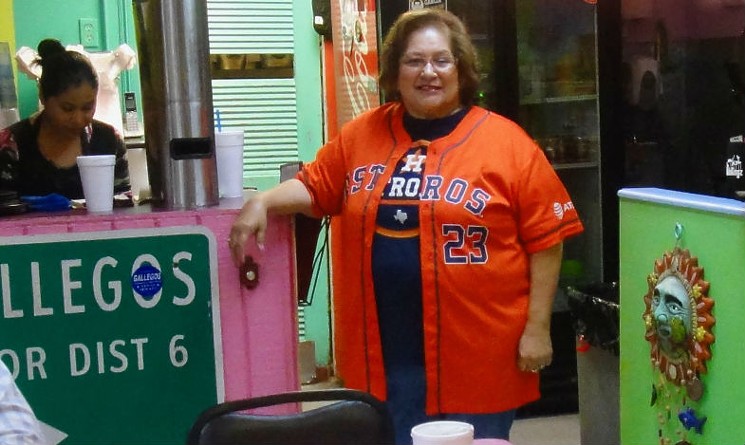
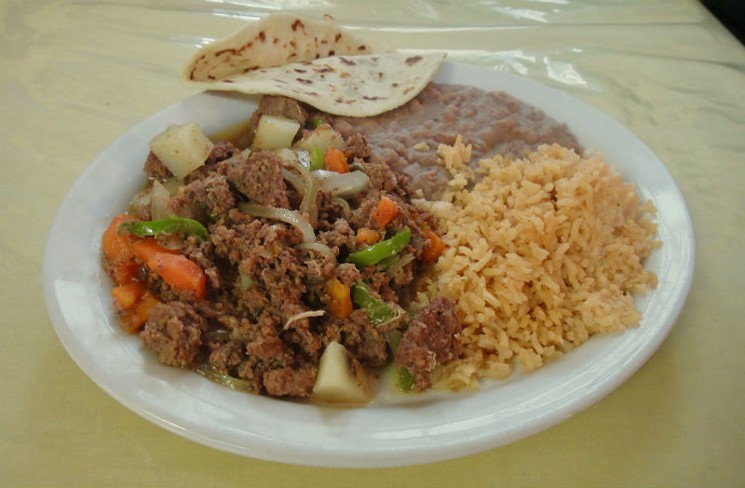
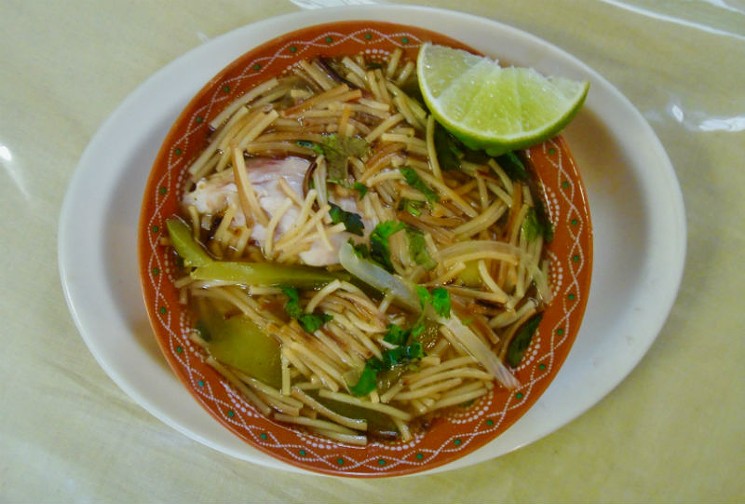
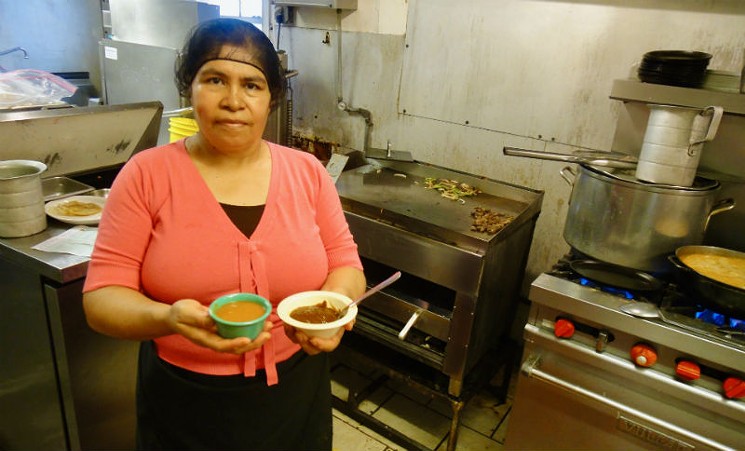
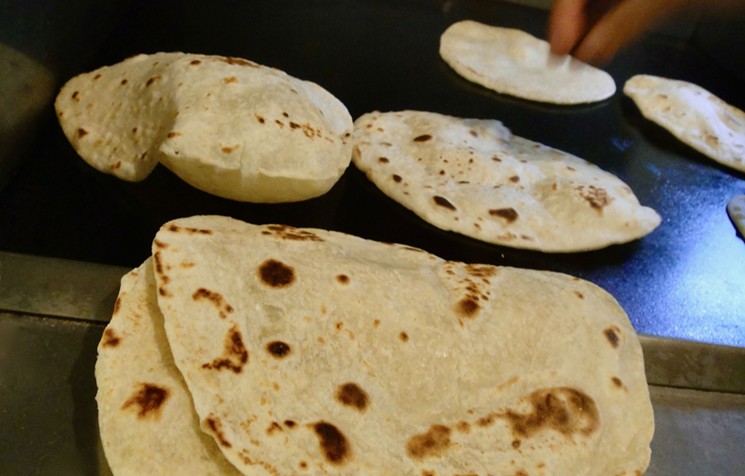
No comments:
Post a Comment